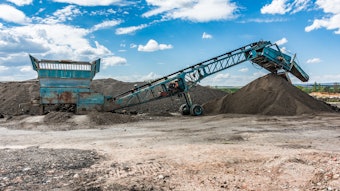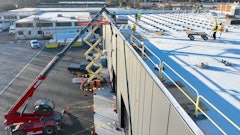
With the construction industry on the upswing and with 2013 construction starts on the whole advancing 6% to $516.8 billion over the year prior according to McGraw Hill Construction (a division of McGraw Hill Financial), attentions are turning to emerging building methodologies, technology resources and materials that have extreme upside potential and can positively impact bottom lines.
With this in mind, here are three game-changing advancements that will significantly impact building and construction concerns in 2014 and beyond:
Cargo Container Construction With the U.S. new construction industry desperate for ways to cut costs and provide sustainable solutions without undermining quality, cargo container construction is a boon — especially for America’s multi-family, mixed use and commercial markets that are completely underserved despite growing demand for this new and novel building methodology.
The escalating marketplace acceptance of cargo container construction is being driven by the reported superior cost efficiencies, heightened profitability and minimal build time associated with this emerging building option. It’s estimated that, on average, cargo container construction is fully half the costs of other building methods. Shipping container-based construction marries the trend toward sustainable housing solutions with addressing escalating building costs and the surplus of durable, versatile, widely available, economical and code-friendly cargo containers that can be readily repurposed to frame houses, condominiums, dormitories and other residential, retail and commercial structures. In addition, these heavy gauge steel structures only take a fraction of the time to build and are more energy efficient than their counterparts due of a high-purposed combination of new technologies used in the design and construction process.
Given the range of benefits and advantages, architects, contractors and individuals are increasingly seeking retired shipping containers to build homes, offices, apartments, schools, dormitories, artists’ studios, emergency shelters and shops. For example, Travelodge completed a hotel in using cargo container construction methods and finished 6-months early and 10% under alternative building estimates, saving them approximately $900,000. Starbucks is also building hundreds of stores across the U.S. using shipping containers. Real estate developer Three Squared, Inc. has a 20-unit, four-story condominium complex underway that spans 26,000 square feet and integrates 93 shipping containers.
Building Industry Modeling (BIM) Software The emerging BIM process allows building designers and architects to work in “5-D” — a 3-D model of the project with the 4th and 5th dimension being the addition of scheduling and cost estimating, respectively.
Using BIM, developers can employ an integrative project delivery approach to planning and design and bring all members of the architectural, design, engineering, construction and environmental teams to the table at the onset of a project. This team can then benefit from a 3-D model of the structure to see each individual consideration, and with clash detection capabilities that seamlessly integrate input from architectural drawings, MEPS designs, constructability and interior designs into a holistic building approach. By seeing a project from a whole building vantage point rather than viewing a building plan as a series of silos, developers are capable of producing efficiencies and a more streamlined approach to the design and construction process.
Benefits associated with employing BIM software include reduced errors and reworks and an overall maximized project outcome with long-term savings.
Insulation Advancements
Insulation needs with regard to nontraditional building methods, including solar and cargo containers among others, differ greatly from customary approaches and solutions. Insulation for emerging building methods must create an easy-to-manage living environment from a thermal comfort perspective while minimizing the space utilization requirement to create a desirable effect. Traditional insulation actually does not stop the transfer of heat or cold between external environments and interior living spaces, but rather it simply works to delay the transfer through multiple inches of material designed to absorb hot and cold.
New insulation, like that being manufactured by? Cargolinc, actually repels external heat or cold without having to factor in the necessary 4 to 8 inches of insulation space that, in fact, would not mitigate the condensation factor that metal runs against when facing a temperature difference between outside and inside spaces. Thus, traditional insulation would only create moisture in hard-to-reach spaces that would promote mold and rot, rather than a comfortable, appealing living environment in all climates.
Emerging insulation technologies maximize space while providing the highest form of a thermal barrier that utilizes the Bernoulli Effect — the effect that gives wings lift and creates eddies in rivers (and in the case of insulation diverts heat and cold from the surface to block transfer versus attempting to just slow it down as with common insulation).
By spraying the inside and outside of a structure with this sort of product that only requires 20 mm of thickness equating to the depth of two stacked business cards, usable living space is greatly maximized. In addition, this process also eliminates the condensation effect on metal and produces a comfortable environment even in such remote locations as the desert and above the Arctic Circle. This allows scaling down HVAC systems to meet the reduced demand, which with this method is not competing with the transfer/loss of heat and cold to the exterior environment. All combined this lowers operating costs for building facility managers and homeowners.
For a complete, interactive version of this article, click here to download the Summer 2014 issue of Sustainable Construction.

![Img 1707[56]](https://img.forconstructionpros.com/files/base/acbm/fcp/image/2023/04/IMG_1707_56_.6437076c97961.png?auto=format%2Ccompress&fit=crop&h=191&q=70&rect=0%2C462%2C1920%2C1080&w=340)















![Glp Porsche 072723 465 64ee42287c29e[1]](https://img.forconstructionpros.com/files/base/acbm/fcp/image/2024/03/GLP_PORSCHE_072723_465.64ee42287c29e_1_.65e88b8589b9c.png?auto=format%2Ccompress&fit=crop&h=135&q=70&rect=0%2C520%2C2250%2C1266&w=240)








